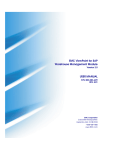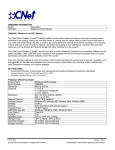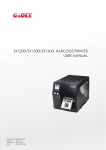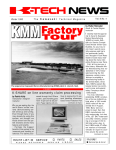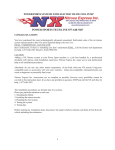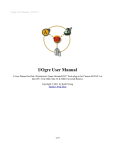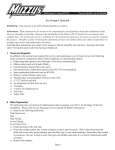Download PBS archive add on CCO - Manual Part C - User Manual -
Transcript
CWM the PBS archive add on for Warehouse Management Manual Part C - Display and Evaluation - Compatible with SAP R/3 4.x SAP ERP 5.0 SAP ERP 6.0 April 24, 2013 PBS archive add on CWM - Display and Evaluation - © 2001 - 2013 PBS Software GmbH Schwanheimer Strasse 144a D-64625 Bensheim, Germany Phone: +49 - 6251 - 174 0 Fax: +49 - 6251 - 174 174 email: [email protected] Internet: www.pbs-software.com PBS archive add ons® is a registered trademark of PBS Software GmbH, Bensheim. SAP, R/3, SAP ERP, SAP Netweaver, ABAP and others are registered trademarks of SAP AG, Walldorf/Baden. Acrobat Reader is a registered trademark of Adobe Systems Incorporated. 2 PBS archive add on CWM - Display and Evaluation - Introduction to the PBS ILM Concept Information Lifecycle Management Information Lifecycle Management (ILM) means the administration of information related to the time when it is used, taking into account its total costs and compliance. A conclusive, efficient ILM concept must, as a result, control data growth, manage retention rules, and also ensure compliant data storage. Furthermore, an easy access to archived data is decisive and, for example, its transfer during internal and external audits. PBS ILM Concept PBS software provides existing SAP customers extensive solutions to put into practice the requirements that were described above for a stringent and successful ILM concept. PBS is considered as an expert for complex, integrated data accesses to archived and database data and meanwhile, also to data that is located on decommissioned SAP systems. In addition to classical SAP data archiving, SAP BI-specific nearline storage is also supported. PBS archive add ons® PBS archive add ons always rely on SAP archiving having been carried out successfully. This is the basis for a permanently high-performing SAP system. In principle, you can indeed retain posted documents in the SAP database for a very long time due to a large database capacity. Depending on the document volume, this may result, however, in massive performance losses and, sooner or later, heavily increasing operation costs. The daily backup becomes difficult for large data stocks, for example. A convenient display and evaluation of archived transaction data – as the SAP user is used to for database data – can often only be carried out in a very restricted manner using SAP standard means depending on the application module. This is particularly the case for large archive data stocks. The PBS archive add ons can be used here. They can be provided for nearly all SAP modules and release levels, and start with a "C" (for Complete) in their description. For example, PBS archive add on CCOPA for the SAP module COPA. Using the PBS archive add ons you can quickly and easily access your archived data even after data archiving during your day-to-day business. The unrestricted data access is realized by an intelligent indexing concept. It extends the SAP archive infrastructure components and integrates itself optimally with SAP archiving. Archive data that has been indexed can still be provided after a release upgrade immediately, without restrictions, and without migration effort. The PBS archive index is stored in sequential files of the SAP file system in the same way as the SAP archive data. Afterwards, you can access the archive data online via the familiar 3 PBS archive add on CWM - Display and Evaluation - transactions. The SAP user can display the data from the SAP database and the archive data simultaneously via the PBS archive add on index. For the user, it seems as though the archived data is still in the SAP database. The deep integration of the PBS transactions also enables direct navigation to subsequent and previous documents both within the indexed SAP module as well as to linked documents from other SAP modules. This applies not only for resident but also without restrictions for archived data. The benefit for the user increases the more PBS archive add ons are used. The potential benefits of the ILM concept raises substantially if you take into account the savings that result from the SAP mirror systems. There are usually at least two of them meaning that the saved disk storage can be tripled by performing data archiving. Thus, time is saved for the data backup. 4 PBS archive add on CWM - Display and Evaluation - Table of Contents 1 Introduction 6 2 Application Functions 7 2.1 Navigation in the PBS archive add on CWM up to 4.5x 7 2.2 Navigation in the PBS archive add on CWM from 4.6 9 3 2.3 Integration in the Menu ‘Warehouse Management‘ 11 2.4 Display Transactions 13 2.5 Transaction “Display Transfer Order” 15 2.6 Transaction “Transfer Orders for Material” 16 2.7 Printing of Documents 18 2.8 Transaction “Display Transfer Requirements” 19 2.9 Transaction “TRs for Storage Type” 20 Adjustment of Customer Reports 22 3.1 Logical Databases 22 3.2 Access via Conversion Tool 23 5 PBS archive add on CWM - Display and Evaluation - 1 Introduction The PBS archive add ons are constructed in modular form and cover the application modules FI, SD, MM, CO etc. with a special program package for exactly this application. You can easily see from the name which PBS archive add on belongs to which SAP module: CFI, CSD, CMM, CCO etc. All PBS archive add ons have in common that they can be easily installed in the SAP R/3 system via the SAP transport utilities "tp" and “SAINT”. For installation details of the PBS archive add ons please see the specific installation manual (manual part A). This manual on the display transaction and application programs was written to support you when using the PBS archive add on CCO. Please see the administration manual (part B) regarding construction and administration of the PBS archive add on CWM. The modular user manual of each PBS archive add on is composed of partial manuals: - Part A: Installation - Part B: Administration, Archive Construction and Maintenance - Part C: Application Programs / Transactions - Part D: Migration Support R/2 => R/3 (if available) There are additional manuals for the PBS utilities: Conversion Tool, Archive Browser, Translation Tool. Should you have questions regarding the installation of the PBS archive add ons or if you have problems when installing the software please call directly the Service Hotline of PBS Software GmbH: Phone: +49 - 6251 - 174 110 Fax: +49 - 6251 - 174 174 email: [email protected] Release Compatibility The PBS archive add on CWM discussed in this manual runs with the basis programs of SAP AG, D-69190 Walldorf/Baden, system R/3, releases 3.0, 3.1, 4.0, 4.5, 4.6, R/3 Enterprise, ECC 5.0, ECC 6.0, correction levels a to z. 6 PBS archive add on CWM - Display and Evaluation - 2 Application Functions 2.1 Navigation in the PBS archive add on CWM up to 4.5x PBS has integrated a start menu in its software that corresponds to the SAP standard menu S000 after logging on to the SAP system. The only difference is the additional function key "PBS archive add ons". In order to use this menu, you only have to enter start menu YPBS for users up to 3.1 or /PBS/PBS for users in all 4.0 releases and /PBS/PBS_45 from release 4.5. Alternatively, for releases 4.0 to 4.5 you can start via the PBS main menu /PBS/MAIN, and from there via the menu path Logistics Ö Material Management Ö PBS archive add on CWM (from rel. 4.5 via Logistics Ö Logistics Execution Ö PBS archive add on CWM) you get to the submenu for control of CWM. If you are only using the PBS archive add on CWM you can start this directly via the menu transaction /PBS/CWM. Alternatively, the warehouse management menu /PBS/LLVS, which has been extended to include CWM transactions, can be started. 7 PBS archive add on CWM - Display and Evaluation - Diagram 1: Menu transactions /PBS/MAIN and /PBS/CWM 8 PBS archive add on CWM - Display and Evaluation - 2.2 Navigation in the PBS archive add on CWM from 4.6 From release 4.6 the main menu /PBS/PBS and menu /PBS/CWM (warehouse management functions) can be integrated in the existing activity group (4.6B) or roles (from 4.6C). Diagram 2: Standard role with menu /PBS/PBS 9 PBS archive add on CWM - Display and Evaluation - 10 PBS archive add on CWM - Display and Evaluation - 2.3 Integration in the Menu ‘Warehouse Management‘ The menu 'Warehouse Management' of the MM-WM area (menu LLVS) is to be updated in the R/3 release 4.0 in the following places: Tools Ö ABAP/4 Workbench Ö Development Ö Ö Other tools Ö Area menu maintenance Ö Menu LLVS. (Identical to transaction SE43). Diagram 3: Menu LLVS with PBS archive add on CWM 11 PBS archive add on CWM - Display and Evaluation - 12 Several steps are necessary in order to integrate the archive submenu in the menu ‘Warehouse Management’: a) In table TADIR you have to set the source system to <SID> (e.g. C11) and the edit flag to 'R' for the object ‘R3TR TRAN LLVS’. b) Next, you have to enter a key for the maintenance of the object ‘R3TR PROG MENULLVS’. You must apply for this key at SAP, which can be done easiest via OSS (Online Service System). c) Repeat step a) for the object ‘R3TR PROG MENULLVS’. You are then authorized to update the warehouse management menu LLVS. As an alternative, the warehouse management menu /PBS/LLVS, which already contains the enhancements, can be started. PBS archive add on CWM - Display and Evaluation - 2.4 Display Transactions The PBS archive add on CWM makes available for online processing warehouse management documents that have been removed from the R/3 database by the document reorganization with transaction SARA. Version 1.0 provides the following display transactions that read not only documents from the operative tables of the SAP system, but also documents from the PBS archive. PBS Rel. >= 4.x /PBS/LT21 /PBS/LT23 /PBS/LT22 /PBS/LT24 /PBS/LT25 /PBS/LT26 /PBS/LT27 /PBS/LT31 /PBS/LX10 /PBS/LX11 /PBS/LX12 /PBS/LX13 /PBS/LX14 /PBS/LX32 /PBS/LB03 /PBS/LB10 /PBS/LB11 /PBS/LB12 /PBS/LB13 /PBS/LX09 /PBS/LX33 /PBS/LU03 /PBS/LU04 /PBS/LI03N /PBS/LX22 /PBS/LX17 /PBS/LX25 /PBS/CWM /PBS/LLVS /PBS/PBS PBS Rel. 3.x ZT21 ZT23 ZT22 ZT24 ZT25 ZT26 ZT27 ZT31 ZX10 ZX11 ZX12 ZX13 ZX14 ZX32 ZB03 ZB10 ZB11 ZB12 ZB13 ZX09 ZX33 ZCWM ZLVS ZPBS SAP LT21 LT23 LT22 LT24 LT25 LT26 LT27 LT31 LX10 LX11 LX12 LX13 LX14 LX32 LB03 LB10 LB11 LB12 LB13 LX09 LX33 LU03 LU04 LI03N LX22 LX17 LX25 LLVS Transaction Description Transfer order single Transfer orders by number Transfer orders by storage type Transfer orders by material Transfer orders for group Transfer orders for storage bin Transfer orders for storage unit Print transfer order manually Movements/Storage Type Document overview Detailed overview Analysis of differences Analysis of Material Transfer Frequency Archived transfer orders Display Transfer Requirement TRs for Storage Type TRs for Material TRs and Posting Change for Mat. Doc. TRs for Requirement Overview of all Transfer Requirements Archived Transfer Requirements Display Posting Change Notice Selection of Posting Change Notices Display System Inventory Record Process Inventory from Overview List of Inventory Differences Inventory Status Menu CWM Menu WM (with CWM transactions) Menu PBS Table 1: Transactions of the PBS archive add on CWM and the corresponding SAP original transactions for. 13 PBS archive add on CWM - Display and Evaluation - As already explained in the installation manual (part A), from release 4.0 PBS Software GmbH has its own naming area. The names of the programs and objects described in this manual originate exclusively from this naming area. For customers using an SAP release up to 3.1, the PBS transactions from release 4.0 are listed in Table 1 along with those for the releases up to 3.1. All transactions that display the archived data are identical to the standard SAP transactions. This guarantees that the users can work immediately with the archive transactions without requiring additional training. See Table 1 for the names of the archive transactions. The transactions can be called by indicating the PBS transaction code, or integrated in the menu 'Warehouse Management' (see chapter 2.3). 14 PBS archive add on CWM - Display and Evaluation - 2.5 Transaction “Display Transfer Order” The archive transaction /PBS/LT21 displays a single transfer order. In the selection screen, the only difference between the PBS transaction and the SAP original is that the other menu options are inactive. In the course of the transaction you can recognize the difference between the PBS and the SAP transactions on the basis of the archive indicator "*" (see Diagram 4). Diagram 4: Part of an item list from transaction /PBS/LT21 You can see from the additional field “Archive” whether the displayed transfer order is located in the PBS archive add on or in the SAP database. In the first case the field contains the symbol ‘*‘; otherwise it is empty. 15 PBS archive add on CWM - Display and Evaluation - 2.6 Transaction “Transfer Orders for Material” In this section we discuss the example of the archive transaction /PBS/LT24, which displays the transfer orders for the material. The transactions /PBS/LT22 to /PBS/LT28 as well as /PBS/LX10 to /PBS/LX14 are identical during display and handling. Diagram 5 shows the request screen of the transaction /PBS/LT24. Diagram 5: Initial screen of transaction /PBS/LT24 Besides the standard delimitations, the screen mask contains a further delimitation specifically for the PBS archive add on. The transaction /PBS/LT24 can display data from the archive and from the SAP database. To select the data source, use the parameter '1=Database+Archive 2=DB 16 PBS archive add on CWM - Display and Evaluation - (=database) 3=Arch (=archive)'. By entering the corresponding number 1, 2 or 3, the transfer orders are displayed either from the R/3 database, the archive or from both data sources. For example, if you search for all operations you should qualify this parameter with '3' as you can therefore save database accesses to the SAP files and reduce the general load on the system. If all delimitations have been entered correctly, the system provides a list displaying the requested transfer orders for the material. Diagram 6 shows such a list. Diagram 6: List of transaction /PBS/LT24. The list screen is identical to the transaction LT24, however, it also includes the archive indicator. You can see from the last column whether the displayed order is contained in the PBS archive add on or in the SAP database. In the first case the last column contains the symbol ‘*‘; otherwise it is empty. Diagram 6 displays both data from the database as well as from the PBS archive add on. By positioning the cursor on a document and double-clicking the left mouse button, you branch to the transaction /PBS/LT21 ('Display Transfer Order'), which displays the document identically to transaction LT21. 17 PBS archive add on CWM - Display and Evaluation - 2.7 Printing of Documents There are two possibilities for printing transfer orders from your PBS archive add on CWM. On the one hand you can export your document via transaction /PBS/LT31 to a printer. /PBS/LT31 reads the document data and passes them to a certain printing report, which is assigned to the respective warehouse number in customizing (Customizing Æ Logistics Execution Æ Warehouse Management Æ Tools Æ Develop Forms Æ Assign Print Programs Æ Assign print program to warehouse number). The existing SAP standard printing reports have the name RLVSDRxx (xx=00, 10 or 40). On the other hand, you can directly start the report /PBS/RLVSDRxx, which corresponds to the respective SAP standard printing report. You use this report to print documents of the PBS archive add on CWM. To do this, enter the document number of the transfer order document that you want to print. Diagram 7 shows the entry mask of the report. Diagram 7: Selection screen of the printing program /PBS/RLVSDR00. To select the data source, use the parameter '1=Database+Archive 2=DB (=database) 3=Arch (=archive)'. 18 PBS archive add on CWM - Display and Evaluation - 2.8 Transaction “Display Transfer Requirements” The archive transaction /PBS/LB03 displays a single transfer order. In the selection screen, the only difference between the PBS transaction and the SAP original is that the other menu options are inactive. In the course of the transaction you can recognize the difference between the PBS and the SAP transactions on the basis of the archive indicator "*" (see Diagram 8). Diagram 8: Part of an item list from transaction /PBS/LB03 You can see from the additional field “Archive” whether the displayed transfer order is located in the PBS archive add on or in the SAP database. In the first case the field contains the symbol ‘*‘; otherwise it is empty. 19 PBS archive add on CWM - Display and Evaluation - 2.9 Transaction “TRs for Storage Type” In this section we discuss the example of the archive transaction /PBS/LB10, which displays the transfer requirements for the storage type. The transactions /PBS/LB11 to /PBS/LB13, /PBS/LX09 and /PBS/LX33 are identical during display and handling. Diagram 9 shows the request screen of the transaction /PBS/LB10. 20 PBS archive add on CWM - Display and Evaluation - Diagram 9: Initial screen of transaction /PBS/LB10 Besides the standard delimitations, the screen mask contains a further delimitation specifically for the PBS archive add on. The transaction /PBS/LB10 can display data from the archive and from the SAP database. To select the data source, use the parameter '1=Database+Archive 2=DB (=database) 3=Arch (=archive)'. By entering the corresponding number 1, 2 or 3, the transfer orders are displayed either from the R/3 database, the archive or from both data sources. For example, if you search for all operations you should qualify this parameter with '3' as you can therefore save database accesses to the SAP files and reduce the general load on the system. If all delimitations have been entered correctly, the system provides a list displaying the requested orders for the material. Diagram 10 shows such a list. Diagram 10: List of transaction /PBS/LB10. The list screen is identical to the transaction LB10, however, it also includes the archive indicator. You can see from the last column whether the displayed order is contained in the PBS archive add on or in the SAP database. In the first case the last column contains the symbol ‘*‘; otherwise it is empty. Diagram 10 displays both data from the database as well as from the PBS archive add on. By positioning the cursor on a document and double-clicking the left mouse button, you branch to the transaction /PBS/LB03 ('Display Transfer Requirement), which displays the document identically to the transaction LB03. 21 PBS archive add on CWM - Display and Evaluation - 3 Adjustment of Customer Reports 3.1 Logical Databases If you want to write own evaluations for warehouse management documents from the database and the PBS archive add on CWM or if you want to extend existing evaluations for the PBS archive add on, the following logical databases are available: /PBS/T1L /PBS/T2L /PBS/T3L /PBS/T4L /PBS/T5L /PBS/R0L /PBS/B1L /PBS/R1L /PBS/I1L /PBS/I3L - transfer orders by number transfer orders by material transfer orders by storage type transfer order for printing transfer order for group (up to 4.0: reference number) Read transfer orders from SAP archive transfer requirements by number transfer requirements by number Inventory data for storage bin Inventory documents In each case it is possible to restrict the selection to the PBS archive add on. 22 PBS archive add on CWM - Display and Evaluation - 3.2 Access via Conversion Tool ABAP reports, accessing the R/3 database via the SELECT command, can be modified with the PBS Conversion Tool in a way that they can also access the data from the PBS archive add on. For this purpose, function module /PBS/SELECT_INTO_TABLE (respectively 3.x: SELECT_PBS_INTO_TABLE) is used, accessing the archive add on and returning in an internal table the data records of the requested table. For more details, please see the manual PBS Conversion Tool. 23























